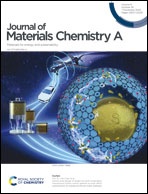Two-dimensional molybdenum carbides: active electrocatalysts for the nitrogen reduction reaction†
Abstract
The nitrogen reduction reaction (NRR) is a promising alternative method to the Haber–Bosch process to produce ammonia due to its mild reaction conditions. The efficiency of the NRR is highly dependent on the catalysts involved. Here, we report that two-dimensional molybdenum carbides, 1T-Mo2C, 2H-Mo2C and MoC2 (edge), are high-performance electrocatalysts for the NRR. In terms of thermodynamics, the highest reaction Gibbs free-energy is 0.52 eV, 0.86 eV and 0.63 eV for the basal planes of 1T-Mo2C and 2H-Mo2C and the (100) edge plane of MoC2, respectively. Bader charge analysis indicates that the exposed Mo atoms bonded to NxHy (x = 1 and 2; 0 < y < 5) groups are the main contributors to the electron transfer from the catalysts to the NxHy groups, leading to the high NRR catalytic activity. Therefore, it is suggested that materials with exposed transition-metal atoms or single transition-metal atom catalysts may both serve as excellent NRR electrocatalysts.



 Please wait while we load your content...
Please wait while we load your content...